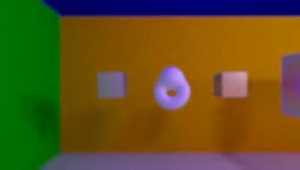Information
- Publication Type: Master Thesis
- Workgroup(s)/Project(s):
- Date: November 2017
- Date (Start): 3. June 2014
- Date (End): 17. November 2017
- TU Wien Library:
- Diploma Examination: 17. November 2017
- First Supervisor: Michael Wimmer
- Keywords: global illumination, frame-rate upsampling, temporal coherence
Abstract
Computer-generated video sequences with a frame-rate higher than the usual 24 images per second, such as 48 or 60 frames per second, have become more popular in the respective industries, due to more visual fidelity. This, however, results in more computational costs for the same length of the video sequence.One solution to this problem is the so-called frame-rate upsampling, which makes use of temporal and spatial coherence to approximate new frames and therefore saves computational time. Several methods have been published in this field, for the purposes of real-time rendering as well as for offline rendering algorithms.
In this thesis, two new algorithms for fame-rate upsampling are introduced. Those are targeted at high-quality computer-generated images that feature various globalillumination effects. The two new algorithms make use of a video denoising method - the non-local means algorithm - to find the appropriate pixel colors for the frame, that has to be upsampled. To find the corresponding pixels in another frame, the methods of this thesis either use existing color information or require additional data, which can be extracted from any global-illumination algorithm with minimal further computations. The proposed methods are aimed at handling reflections and refractions in the scene better than previous work.
Additional Files and Images
Weblinks
No further information available.BibTeX
@mastersthesis{ROEGNER-2014-TUI,
title = "Temporal Upsampling for Image Sequences Using a Non-Local
Means Algorithm",
author = "Clemens R\"{o}gner",
year = "2017",
abstract = "Computer-generated video sequences with a frame-rate higher
than the usual 24 images per second, such as 48 or 60 frames
per second, have become more popular in the respective
industries, due to more visual fidelity. This, however,
results in more computational costs for the same length of
the video sequence. One solution to this problem is the
so-called frame-rate upsampling, which makes use of temporal
and spatial coherence to approximate new frames and
therefore saves computational time. Several methods have
been published in this field, for the purposes of real-time
rendering as well as for offline rendering algorithms. In
this thesis, two new algorithms for fame-rate upsampling are
introduced. Those are targeted at high-quality
computer-generated images that feature various
globalillumination effects. The two new algorithms make use
of a video denoising method - the non-local means algorithm
- to find the appropriate pixel colors for the frame, that
has to be upsampled. To find the corresponding pixels in
another frame, the methods of this thesis either use
existing color information or require additional data, which
can be extracted from any global-illumination algorithm with
minimal further computations. The proposed methods are aimed
at handling reflections and refractions in the scene better
than previous work.",
month = nov,
address = "Favoritenstrasse 9-11/E193-02, A-1040 Vienna, Austria",
school = "Institute of Computer Graphics and Algorithms, Vienna
University of Technology ",
keywords = "global illumination, frame-rate upsampling, temporal
coherence",
URL = "https://www.cg.tuwien.ac.at/research/publications/2017/ROEGNER-2014-TUI/",
}

 poster
poster thesis
thesis


